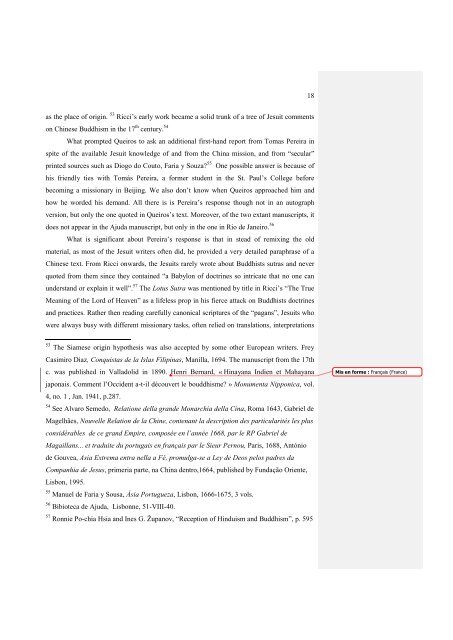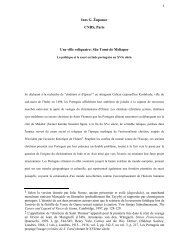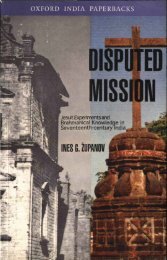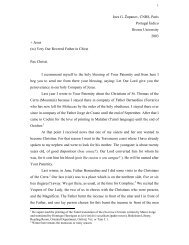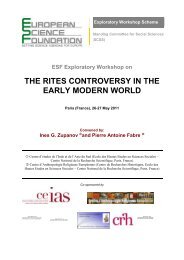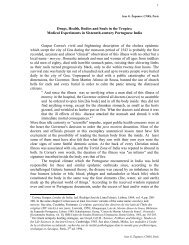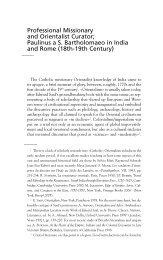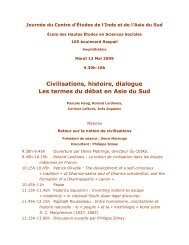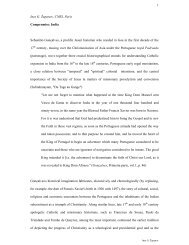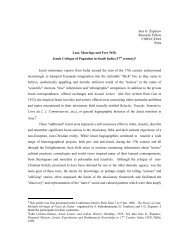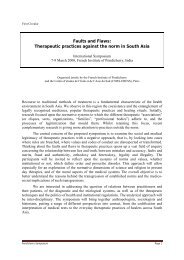Jesuit Orientalism; - Ines G. Županov
Jesuit Orientalism; - Ines G. Županov
Jesuit Orientalism; - Ines G. Županov
You also want an ePaper? Increase the reach of your titles
YUMPU automatically turns print PDFs into web optimized ePapers that Google loves.
18<br />
as the place of origin. 53 Ricci‟s early work became a solid trunk of a tree of <strong>Jesuit</strong> comments<br />
on Chinese Buddhism in the 17 th century. 54<br />
What prompted Queiros to ask an additional first-hand report from Tomas Pereira in<br />
spite of the available <strong>Jesuit</strong> knowledge of and from the China mission, and from “secular”<br />
printed sources such as Diogo do Couto, Faria y Souza? 55 One possible answer is because of<br />
his friendly ties with Tomás Pereira, a former student in the St. Paul‟s College before<br />
becoming a missionary in Beijing. We also don‟t know when Queiros approached him and<br />
how he worded his demand. All there is is Pereira‟s response though not in an autograph<br />
version, but only the one quoted in Queiros‟s text. Moreover, of the two extant manuscripts, it<br />
does not appear in the Ajuda manuscript, but only in the one in Rio de Janeiro. 56<br />
What is significant about Pereira‟s response is that in stead of remixing the old<br />
material, as most of the <strong>Jesuit</strong> writers often did, he provided a very detailed paraphrase of a<br />
Chinese text. From Ricci onwards, the <strong>Jesuit</strong>s rarely wrote about Buddhists sutras and never<br />
quoted from them since they contained “a Babylon of doctrines so intricate that no one can<br />
understand or explain it well”. 57 The Lotus Sutra was mentioned by title in Ricci‟s “The True<br />
Meaning of the Lord of Heaven” as a lifeless prop in his fierce attack on Buddhists doctrines<br />
and practices. Rather then reading carefully canonical scriptures of the “pagans”, <strong>Jesuit</strong>s who<br />
were always busy with different missionary tasks, often relied on translations, interpretations<br />
53 The Siamese origin hypothesis was also accepted by some other European writers. Frey<br />
Casimiro Diaz, Conquistas de la Islas Filipinas, Manilla, 1694. The manuscript from the 17th<br />
c. was published in Valladolid in 1890. Henri Bernard, « Hinayana Indien et Mahayana<br />
japonais. Comment l‟Occident a-t-il découvert le bouddhisme? » Monumenta Nipponica, vol.<br />
4, no. 1 , Jan. 1941, p.287.<br />
54 See Alvaro Semedo, Relatione della grande Monarchia della Cina, Roma 1643, Gabriel de<br />
Mis en forme : Français (France)<br />
Magelhães, Nouvelle Relation de la Chine, contenant la description des particularités les plus<br />
considérables de ce grand Empire, composée en l‟année 1668, par le RP Gabriel de<br />
Magaillans... et traduite du portugais en français par le Sieur Pernou, Paris, 1688, António<br />
de Gouvea, Asia Extrema entra nella a Fé, promulga-se a Ley de Deos pelos padres da<br />
Companhia de Jesus, primeria parte, na China dentro,1664, published by Fundação Oriente,<br />
Lisbon, 1995.<br />
55 Manuel de Faria y Sousa, Ásia Portugueza, Lisbon, 1666-1675, 3 vols.<br />
56 Bibioteca de Ajuda, Lisbonne, 51-VIII-40.<br />
57 Ronnie Po-chia Hsia and <strong>Ines</strong> G. <strong>Županov</strong>, “Reception of Hinduism and Buddhism”, p. 595


